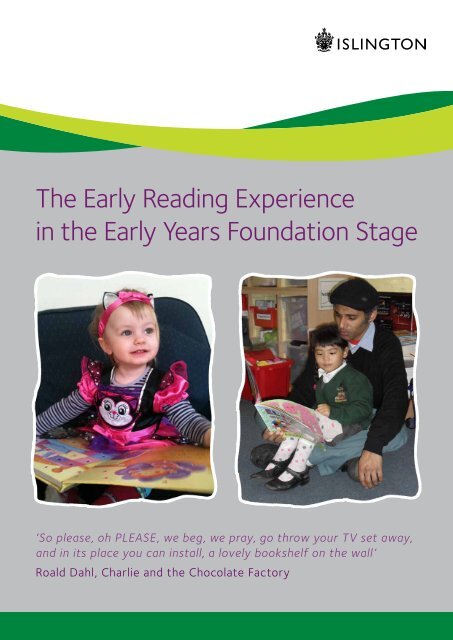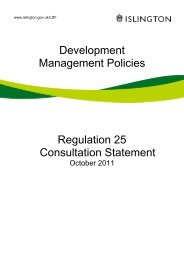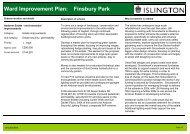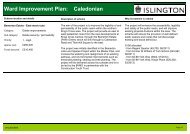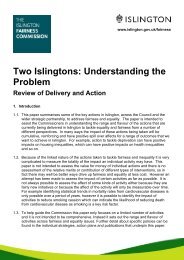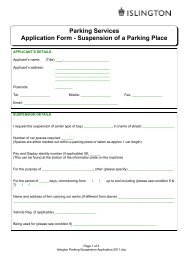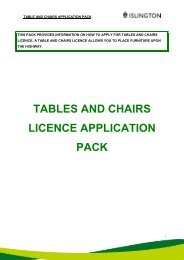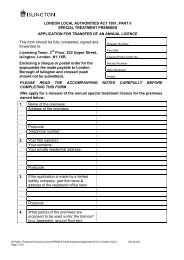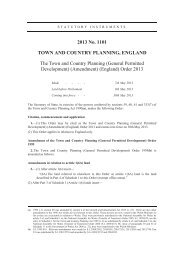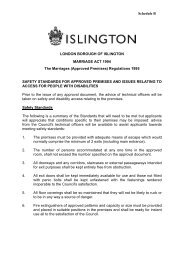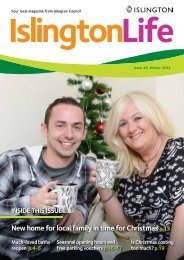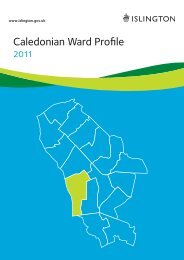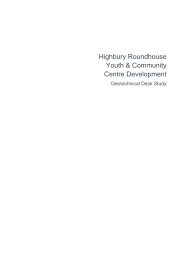The Early Reading Experience in the Early Years Foundation Stage
The Early Reading Experience in the Early Years Foundation Stage
The Early Reading Experience in the Early Years Foundation Stage
Create successful ePaper yourself
Turn your PDF publications into a flip-book with our unique Google optimized e-Paper software.
<strong>The</strong> <strong>Early</strong> <strong>Read<strong>in</strong>g</strong> <strong>Experience</strong><br />
<strong>in</strong> <strong>the</strong> <strong>Early</strong> <strong>Years</strong> <strong>Foundation</strong> <strong>Stage</strong><br />
‘So please, oh PLEASE, we beg, we pray, go throw your TV set away,<br />
and <strong>in</strong> its place you can <strong>in</strong>stall, a lovely bookshelf on <strong>the</strong> wall’<br />
Roald Dahl, Charlie and <strong>the</strong> Chocolate Factory
Introduction<br />
This document was <strong>in</strong>spired by a short project called <strong>the</strong> ‘<strong>Early</strong> <strong>Read<strong>in</strong>g</strong> <strong>Experience</strong><br />
Initiative’. It sets out some key areas of effective practice and provision for read<strong>in</strong>g<br />
<strong>in</strong> early years sett<strong>in</strong>gs and highlights a number of case studies from schools who<br />
participated <strong>in</strong> <strong>the</strong> project.<br />
<strong>The</strong> project was jo<strong>in</strong>tly developed by <strong>the</strong> <strong>Early</strong> <strong>Years</strong> <strong>Foundation</strong> <strong>Stage</strong> Team and <strong>the</strong><br />
Isl<strong>in</strong>gton Education Library Service with <strong>in</strong>put from <strong>the</strong> Primary Learn<strong>in</strong>g and Teach<strong>in</strong>g<br />
team and took place dur<strong>in</strong>g <strong>the</strong> summer term 2010 <strong>in</strong> n<strong>in</strong>e Isl<strong>in</strong>gton reception and nursery<br />
classes. It was carried out <strong>in</strong> response to an <strong>in</strong>crease <strong>in</strong> L<strong>in</strong>k<strong>in</strong>g Sounds and Letters EYFSP<br />
scores but a decrease <strong>in</strong> <strong>the</strong> scores for <strong>Read<strong>in</strong>g</strong> and Writ<strong>in</strong>g.<br />
<strong>The</strong> project consisted of a launch event at <strong>the</strong> education library, two days of consultant<br />
support over <strong>the</strong> term and a literacy audit lead<strong>in</strong>g to an action plan. Participat<strong>in</strong>g<br />
practitioners attended a series of tra<strong>in</strong><strong>in</strong>g sessions <strong>in</strong>clud<strong>in</strong>g us<strong>in</strong>g core books, develop<strong>in</strong>g<br />
high quality book corners, work<strong>in</strong>g with parents and guided read<strong>in</strong>g. Participat<strong>in</strong>g schools<br />
were encouraged to write case studies highlight<strong>in</strong>g <strong>the</strong> impact of <strong>the</strong> project.<br />
Impact was measured through review and evaluation of action plans, through cases studies and<br />
analysis of EYFSP results <strong>in</strong> June 2010. Results showed that <strong>the</strong> most significant <strong>in</strong>crease across<br />
all 13 scales was <strong>in</strong> read<strong>in</strong>g scores, which rose by more than 10%. This demonstrated that<br />
66.8% of children scored 6+ <strong>in</strong> read<strong>in</strong>g, <strong>in</strong>dicative of a good level of development. <strong>The</strong> project<br />
was evaluated by all participat<strong>in</strong>g schools as hav<strong>in</strong>g a significant impact on read<strong>in</strong>g scores.<br />
‘Learn<strong>in</strong>g to read <strong>in</strong> English is a complex, sometimes daunt<strong>in</strong>g<br />
challenge for children and <strong>the</strong>ir teachers. <strong>The</strong> sensitive process of<br />
attun<strong>in</strong>g voices, ears, eyes and m<strong>in</strong>ds takes time and practice.<br />
A s<strong>in</strong>gle method may not suit every child and <strong>the</strong> ‘hands on’ sensory<br />
approach of <strong>the</strong> curriculum for under fives is an essential element <strong>in</strong><br />
any successful read<strong>in</strong>g experience’<br />
(Sally Fea<strong>the</strong>rstone 2006)<br />
<strong>The</strong> <strong>Early</strong> <strong>Read<strong>in</strong>g</strong> <strong>Experience</strong><br />
Alongside <strong>the</strong> effective teach<strong>in</strong>g of phonics <strong>the</strong>re are many o<strong>the</strong>r elements <strong>in</strong> learn<strong>in</strong>g to<br />
read that are essential <strong>in</strong> support<strong>in</strong>g children <strong>in</strong> <strong>the</strong>ir journey to becom<strong>in</strong>g competent readers.<br />
Some of <strong>the</strong> follow<strong>in</strong>g aspects are explored <strong>in</strong> more depth below.<br />
• High quality book corners that are accessible, owned and loved by children<br />
• Us<strong>in</strong>g core books to plan for children’s <strong>in</strong>terests and class topics<br />
• Valu<strong>in</strong>g non fiction books<br />
2 Isl<strong>in</strong>gton <strong>Early</strong> <strong>Years</strong> <strong>Foundation</strong> <strong>Stage</strong> Team • <strong>Early</strong> <strong>Read<strong>in</strong>g</strong> • May 2011
• Hav<strong>in</strong>g enthusiastic staff who share <strong>the</strong>ir excitement of books with children<br />
• Hav<strong>in</strong>g books available <strong>in</strong> all areas of <strong>the</strong> classroom<br />
• Hav<strong>in</strong>g opportunities for <strong>in</strong>dependent writ<strong>in</strong>g <strong>in</strong> all areas of <strong>the</strong> classroom<br />
• Hav<strong>in</strong>g well planned guided read<strong>in</strong>g and writ<strong>in</strong>g sessions on a regular basis which aim to<br />
teach <strong>the</strong> important elements of read<strong>in</strong>g and writ<strong>in</strong>g<br />
• Us<strong>in</strong>g story props, sacks and boxes to enhance core books<br />
• Hav<strong>in</strong>g well planned shared read<strong>in</strong>g sessions that all practitioners are confident to take part <strong>in</strong><br />
• Opportunities for children to learn ‘read<strong>in</strong>g behaviours’, for example, <strong>the</strong> recognition that pr<strong>in</strong>t<br />
conveys mean<strong>in</strong>g, <strong>the</strong> left to right directionality of English text, <strong>the</strong> purpose of punctuation<br />
• Involv<strong>in</strong>g parents <strong>in</strong> understand<strong>in</strong>g <strong>the</strong> importance of early literacy though parents<br />
workshops, newsletters etc<br />
• Opportunities for high quality adult- child <strong>in</strong>teractions and susta<strong>in</strong>ed shared th<strong>in</strong>k<strong>in</strong>g to<br />
give children <strong>the</strong> extended vocabulary with which to write creatively<br />
• Encourag<strong>in</strong>g children to become aware of authors by visit<strong>in</strong>g <strong>the</strong>ir local libraries and hav<strong>in</strong>g<br />
visit<strong>in</strong>g authors com<strong>in</strong>g <strong>in</strong> to <strong>the</strong> classroom.<br />
• Listen<strong>in</strong>g to a variety of genres, for example, non fiction, poems, taped stories, rhymes etc<br />
• Opportunities to retell and to act out stories us<strong>in</strong>g props and story maps.<br />
• Activities to help develop a sense of rhythm<br />
<strong>The</strong> <strong>Read<strong>in</strong>g</strong> Diet – Opportunities for Literacy<br />
Children need a range of opportunities to develop as fluent, enthusiastic and critical readers. A<br />
balanced read<strong>in</strong>g experience should <strong>in</strong>clude a range of <strong>the</strong> follow<strong>in</strong>g throughout <strong>the</strong> day/week:<br />
Hear<strong>in</strong>g Books Read Aloud<br />
<strong>Read<strong>in</strong>g</strong> aloud to children for <strong>the</strong>ir pleasure and <strong>in</strong>terest should build enthusiasm and<br />
enjoyment. Children should experience a range of different genres throughout <strong>the</strong> week<br />
<strong>in</strong>clud<strong>in</strong>g stories, rhymes, poems and non fiction. It serves as an important step towards<br />
<strong>in</strong>dependent read<strong>in</strong>g and <strong>in</strong>troduces children to different styles of writ<strong>in</strong>g, to new vocabulary<br />
and tunes <strong>the</strong>m <strong>in</strong> to book language.<br />
Shared <strong>Read<strong>in</strong>g</strong><br />
This provides opportunities for <strong>the</strong> practitioner to model fluent , expressive text read<strong>in</strong>g to<br />
<strong>the</strong> whole class and to demonstrate book behaviours, for example directionality of pr<strong>in</strong>t , <strong>the</strong><br />
function of punctuation, re<strong>in</strong>forc<strong>in</strong>g phonemes, cvc words and high frequency words which<br />
have been previously taught <strong>in</strong> <strong>the</strong> discrete phonics session. Shared read<strong>in</strong>g sessions also<br />
provide an opportunity to expla<strong>in</strong> and explore new vocabulary, which <strong>in</strong> turn helps to develop<br />
comprehension. <strong>The</strong>se sessions are crucial for children learn<strong>in</strong>g English as an additional<br />
language, who are often able to decode new words but may not understand <strong>the</strong>ir mean<strong>in</strong>g.<br />
Isl<strong>in</strong>gton <strong>Early</strong> <strong>Years</strong> <strong>Foundation</strong> <strong>Stage</strong> Team • <strong>Early</strong> <strong>Read<strong>in</strong>g</strong> • May 2011 3
Guided <strong>Read<strong>in</strong>g</strong> (starts <strong>in</strong> reception)<br />
‘This extends <strong>the</strong> opportunities provided by shared read<strong>in</strong>g with a sharp focus on <strong>the</strong> targeted<br />
needs of a particular group with similar read<strong>in</strong>g abilities and needs, <strong>in</strong>clud<strong>in</strong>g vocabulary<br />
development.’ (<strong>Early</strong> <strong>Read<strong>in</strong>g</strong> CPD resource- <strong>The</strong> National Strategies). At <strong>the</strong> earliest stages<br />
of guided read<strong>in</strong>g it is important to carry on with teach<strong>in</strong>g ‘book behaviours’. As <strong>the</strong> child<br />
beg<strong>in</strong>s to apply phonic knowledge, texts should be selected with some words that can be<br />
decoded us<strong>in</strong>g exist<strong>in</strong>g knowledge (90%) and some that provide a degree of challenge (10%).<br />
Careful assessment of children dur<strong>in</strong>g <strong>the</strong> discrete phonics session and through observations<br />
of children engaged <strong>in</strong> all areas of CLLD will help <strong>the</strong> practitioner plan for guided read<strong>in</strong>g. A<br />
guided read<strong>in</strong>g session which focuses on word recognition could be centred around read<strong>in</strong>g<br />
a sentence or caption from a familiar story, or from a simple recipe written out for a cook<strong>in</strong>g<br />
activity. Alternatively a session which focuses on comprehension may use real objects or story<br />
props to stimulate conversation and <strong>the</strong> teach<strong>in</strong>g of new vocabulary.<br />
Speak<strong>in</strong>g and Listen<strong>in</strong>g Sessions<br />
It is important for practitioners to support children’s development <strong>in</strong> communication, speak<strong>in</strong>g and<br />
listen<strong>in</strong>g, as good speak<strong>in</strong>g and listen<strong>in</strong>g skills give children confidence <strong>in</strong> read<strong>in</strong>g and writ<strong>in</strong>g. If<br />
children become familiar with a range of core texts and are able to retell <strong>the</strong>m confidently, <strong>the</strong>y<br />
will be able to apply <strong>the</strong>se skills to read<strong>in</strong>g unfamiliar texts. Knowledge of book language and <strong>the</strong><br />
way that stories are sequenced also helps children with <strong>the</strong>ir creative writ<strong>in</strong>g skills.<br />
Phonological Awareness<br />
Develop<strong>in</strong>g children’s ability to tune <strong>in</strong>to sounds is a crucial element of read<strong>in</strong>g. If children are<br />
able to dist<strong>in</strong>guish between sounds <strong>in</strong> words and are aware of rhyme, rhythm and alliteration,<br />
this will help with read<strong>in</strong>g skills. It is important that children are familiar with a wide range<br />
of rhymes and rhym<strong>in</strong>g books. Instrument sessions will also support children to develop<br />
phonological awareness by help<strong>in</strong>g <strong>the</strong>m to develop a sense of rhythm through clapp<strong>in</strong>g along<br />
to a nursery rhyme or clapp<strong>in</strong>g beats <strong>in</strong> a name. This will help children when <strong>the</strong>y need to<br />
break down long words <strong>in</strong>to units or syllables.<br />
Encourag<strong>in</strong>g <strong>the</strong> Development of <strong>Read<strong>in</strong>g</strong> Throughout <strong>the</strong><br />
Learn<strong>in</strong>g Environment<br />
In a high quality EYFS learn<strong>in</strong>g environment <strong>the</strong>re should a wide range of opportunities to apply<br />
read<strong>in</strong>g skills, for example: alphabet mats, alphabet charts, name cards placed <strong>in</strong> <strong>the</strong> writ<strong>in</strong>g<br />
corner or <strong>in</strong> <strong>the</strong> ICT area, pr<strong>in</strong>t <strong>in</strong> <strong>the</strong> environment, food packag<strong>in</strong>g, clearly labelled resources<br />
and questions on displays and <strong>in</strong> <strong>the</strong> learn<strong>in</strong>g environment. This should cont<strong>in</strong>ue <strong>in</strong> <strong>the</strong> outdoor<br />
environment with signs for role play areas, road signs, a book area or a read<strong>in</strong>g tent.<br />
4 Isl<strong>in</strong>gton <strong>Early</strong> <strong>Years</strong> <strong>Foundation</strong> <strong>Stage</strong> Team • <strong>Early</strong> <strong>Read<strong>in</strong>g</strong> • May 2011
Home School <strong>Read<strong>in</strong>g</strong><br />
It is important to have a well resourced home school read<strong>in</strong>g scheme. This will encourage<br />
parents to read with <strong>the</strong>ir children at home, to re<strong>in</strong>force <strong>the</strong> development of <strong>the</strong>ir read<strong>in</strong>g<br />
skills. Parents can be <strong>in</strong>formed about early read<strong>in</strong>g and writ<strong>in</strong>g through parents workshops and<br />
by hav<strong>in</strong>g a shared dialogue through read<strong>in</strong>g diaries.<br />
A range of books can be sent home, <strong>in</strong>clud<strong>in</strong>g core books, library books and guided read<strong>in</strong>g/<br />
scheme books. Many EYFS classrooms encourage parents to come and read with <strong>the</strong>ir children<br />
at <strong>the</strong> beg<strong>in</strong>n<strong>in</strong>g or end of <strong>the</strong> day or <strong>in</strong>vite parents <strong>in</strong> to carry out story sessions <strong>in</strong> <strong>the</strong>ir<br />
home language.<br />
Isl<strong>in</strong>gton <strong>Early</strong> <strong>Years</strong> <strong>Foundation</strong> <strong>Stage</strong> Team • <strong>Early</strong> <strong>Read<strong>in</strong>g</strong> • May 2011 5
Case Studies<br />
CASE STUDY 1<br />
Margaret Murphy – Nursery Teacher at Ambler Primary School<br />
This case study used non fiction texts to support <strong>the</strong> children’s <strong>in</strong>terests <strong>in</strong> grow<strong>in</strong>g and plant<strong>in</strong>g.<br />
<strong>The</strong> children really enjoyed ‘Jack and <strong>the</strong> Beanstalk’ and from this were especially engaged<br />
with explor<strong>in</strong>g <strong>the</strong> concept of size and growth through plant<strong>in</strong>g and grow<strong>in</strong>g <strong>the</strong>ir own<br />
‘beanstalk’. <strong>The</strong>y were fasc<strong>in</strong>ated by a non fiction text trac<strong>in</strong>g <strong>the</strong> growth of broad beans<br />
and a series of photos which illustrated <strong>the</strong> stages of growth. <strong>The</strong> children were also keen to<br />
produce <strong>the</strong>ir own versions of ‘Jack and <strong>the</strong> Beanstalk’ which became an <strong>in</strong>tegral part of our<br />
display based on <strong>the</strong> text.<br />
Outside we had many conversations with <strong>the</strong> children about <strong>the</strong>ir beans; compar<strong>in</strong>g sizes,<br />
talk<strong>in</strong>g about what plants need to grow, describ<strong>in</strong>g <strong>the</strong> feel of <strong>the</strong> soil and relat<strong>in</strong>g what <strong>the</strong>y<br />
were do<strong>in</strong>g <strong>in</strong> <strong>the</strong> nursery to <strong>the</strong>ir experience of garden<strong>in</strong>g <strong>in</strong> <strong>the</strong>ir own lives. We made written<br />
record<strong>in</strong>gs of our conversations and added <strong>the</strong>se to a display beside <strong>the</strong> plant<strong>in</strong>g troughs.<br />
We went on to plant a herb garden and hav<strong>in</strong>g read ‘<strong>The</strong> Big Hungry Bear’, we planted<br />
strawberry plants. We ensured that a range of relevant non fiction texts were available<br />
to explore on tables near to <strong>the</strong> plant<strong>in</strong>g areas. <strong>The</strong>se texts had vibrant, attractive<br />
photographs which engaged <strong>the</strong> children and led to fur<strong>the</strong>r conversations relat<strong>in</strong>g to<br />
growth, plants and m<strong>in</strong>ibeasts.<br />
In general we became <strong>in</strong>creas<strong>in</strong>gly aware that plac<strong>in</strong>g relevant texts next to <strong>the</strong> learn<strong>in</strong>g<br />
experiences we set up resulted <strong>in</strong> <strong>the</strong> children explor<strong>in</strong>g those texts.<br />
6 Isl<strong>in</strong>gton <strong>Early</strong> <strong>Years</strong> <strong>Foundation</strong> <strong>Stage</strong> Team • <strong>Early</strong> <strong>Read<strong>in</strong>g</strong> • May 2011
Case Studies<br />
CASE STUDY 2<br />
Olivia Quirke – Reception Teacher -St Marys Primary School<br />
This case study highlights <strong>the</strong> importance of hav<strong>in</strong>g a high quality book corner and us<strong>in</strong>g<br />
core books to stimulate children’s <strong>in</strong>terests, enthusiasm and enjoyment of books.<br />
As part of <strong>the</strong> <strong>Early</strong> <strong>Read<strong>in</strong>g</strong> <strong>Experience</strong>s Initiative I carried out a literacy audit and ordered<br />
a set of core books. One of <strong>the</strong> actions was to change our book corner. Children were us<strong>in</strong>g<br />
<strong>the</strong> book corner, however upon reflection it was <strong>the</strong> same children who enjoyed books and<br />
read<strong>in</strong>g that were us<strong>in</strong>g it consistently. I took <strong>the</strong> good advice from <strong>the</strong> project which was<br />
’less is more’. <strong>The</strong> advice was that children are more likely to access book corners if <strong>the</strong> books<br />
are well displayed, preferably with front covers on view and if <strong>the</strong>re are a smaller number of<br />
books available. Books can be rotated regularly to relate to children’s <strong>in</strong>terests.<br />
Our read<strong>in</strong>g area now looks like this:<br />
It is an open area which flows<br />
through <strong>the</strong> classroom, which<br />
children can access more<br />
<strong>in</strong>dependently. <strong>The</strong> book area now<br />
supports <strong>the</strong> writ<strong>in</strong>g area and pupils<br />
are access<strong>in</strong>g both and mak<strong>in</strong>g l<strong>in</strong>ks<br />
with <strong>the</strong> two areas.<br />
I now have <strong>the</strong> core books out and<br />
rotate <strong>the</strong>m regularly. I put smaller<br />
boxes <strong>in</strong>side <strong>the</strong> display unit and on<br />
<strong>the</strong> front of <strong>the</strong> boxes I put small<br />
pictures of <strong>the</strong> front covers of <strong>the</strong><br />
books that should be <strong>in</strong> each box<br />
(see below right).<br />
This has helped <strong>the</strong> pupils immensely<br />
as once it was expla<strong>in</strong>ed to <strong>the</strong>m<br />
about tak<strong>in</strong>g care of books and<br />
putt<strong>in</strong>g <strong>the</strong>m <strong>in</strong> <strong>the</strong> right place, <strong>the</strong>y<br />
all do this now as a matter of course.<br />
<strong>The</strong> children are all now access<strong>in</strong>g<br />
books throughout <strong>the</strong> whole<br />
classroom, both <strong>in</strong>side and outside,<br />
us<strong>in</strong>g various spaces to enjoy <strong>the</strong>m.<br />
Isl<strong>in</strong>gton <strong>Early</strong> <strong>Years</strong> <strong>Foundation</strong> <strong>Stage</strong> Team • <strong>Early</strong> <strong>Read<strong>in</strong>g</strong> • May 2011 7
Case Studies<br />
CASE STUDY 3<br />
Natan Baretto – Reception teacher at Ro<strong>the</strong>rfield Primary School<br />
This short case study highlights <strong>the</strong> importance of <strong>in</strong>volv<strong>in</strong>g parents with <strong>the</strong>ir children’s read<strong>in</strong>g.<br />
Natan is a Portuguese speaker and often speaks and s<strong>in</strong>gs to <strong>the</strong> children <strong>in</strong> his home language.<br />
Tuesday <strong>Read<strong>in</strong>g</strong> Morn<strong>in</strong>gs<br />
Books are scattered on tables, on <strong>the</strong> carpet, <strong>in</strong> corners. <strong>The</strong> children arrive and <strong>the</strong>ir parents<br />
stay with <strong>the</strong>m.<br />
<strong>The</strong>ir mums, dads, nans, grandads and carers stay to read with <strong>the</strong>m. Some can only make 5<br />
m<strong>in</strong>utes; o<strong>the</strong>rs stay for anyth<strong>in</strong>g from 20 m<strong>in</strong>utes to half an hour.<br />
Children choose books and sit with <strong>the</strong>ir parents. O<strong>the</strong>r children ga<strong>the</strong>r around <strong>the</strong>m. Groups<br />
are made and stories are shared, <strong>in</strong> English, Spanish, Portuguese, Japanese, French and Turkish.<br />
<strong>The</strong>y read, <strong>the</strong>y talk, <strong>the</strong>y laugh, enjoy<strong>in</strong>g books <strong>the</strong>y like <strong>in</strong> <strong>the</strong> company of those <strong>the</strong>y love.<br />
Harrison reads with his nan ‘A Viagem da Sement<strong>in</strong>ha’, <strong>in</strong> Portuguese (<strong>The</strong> Journey of <strong>the</strong> Small Seed)<br />
8 Isl<strong>in</strong>gton <strong>Early</strong> <strong>Years</strong> <strong>Foundation</strong> <strong>Stage</strong> Team • <strong>Early</strong> <strong>Read<strong>in</strong>g</strong> • May 2011
Case Studies<br />
CASE STUDY 4<br />
Claire Jolly – Reception teacher at Drayton Park Primary School<br />
In this case study, Claire carried out a literacy audit of her classroom, and <strong>the</strong>n improved<br />
her book area and access to books throughout <strong>the</strong> learn<strong>in</strong>g environment.<br />
Drayton Park School - Sun Class <strong>Read<strong>in</strong>g</strong> Corner<br />
Jolly Phonics letter posters<br />
Pictures of <strong>the</strong> children and <strong>the</strong>ir names underneath<br />
Canopy and bunt<strong>in</strong>g<br />
<strong>The</strong> children have taken over this<br />
board and now display <strong>the</strong>ir own<br />
writ<strong>in</strong>g and pictures<br />
Table with topic books/post-it notes etc.<br />
Choos<strong>in</strong>g books - <strong>the</strong> children can take<br />
<strong>the</strong>se books home to read with <strong>the</strong>ir<br />
families - some dual language books<br />
are <strong>in</strong>cluded<br />
Children’s drawers for stor<strong>in</strong>g <strong>the</strong>ir work/pictures etc.<br />
Core <strong>Read<strong>in</strong>g</strong> Books<br />
- with pictures<br />
so children<br />
can replace <strong>the</strong>m<br />
correctly<br />
Topic Book Area - with animals<br />
(as this is a South Africa/World Cup display)<br />
Puppets are<br />
stored below<br />
Isl<strong>in</strong>gton <strong>Early</strong> <strong>Years</strong> <strong>Foundation</strong> <strong>Stage</strong> Team • <strong>Early</strong> <strong>Read<strong>in</strong>g</strong> • May 2011 9
Case Studies<br />
CASE STUDY 4 (cont<strong>in</strong>ued)<br />
We read everywhere ...<br />
... even <strong>in</strong> <strong>the</strong> playground at playtime!<br />
10 Isl<strong>in</strong>gton <strong>Early</strong> <strong>Years</strong> <strong>Foundation</strong> <strong>Stage</strong> Team • <strong>Early</strong> <strong>Read<strong>in</strong>g</strong> • May 2011
References<br />
<strong>Early</strong> <strong>Read<strong>in</strong>g</strong> Curriculum CPD Resource (2008)<br />
<strong>The</strong> National Strategies<br />
Fea<strong>the</strong>rstone, S (2006) L is for Sheep - Gett<strong>in</strong>g Ready for Phonics<br />
Fea<strong>the</strong>rstone Education Ltd<br />
A Place To Learn – Develop<strong>in</strong>g a Stimulat<strong>in</strong>g Learn<strong>in</strong>g Environment (2006)<br />
Lewisham <strong>Early</strong> <strong>Years</strong> Advice and Resource Network<br />
Shared <strong>Read<strong>in</strong>g</strong> With Beg<strong>in</strong>ner Readers (2008)<br />
<strong>The</strong> National Strategies<br />
For more <strong>in</strong>formation about <strong>the</strong> literacy tra<strong>in</strong><strong>in</strong>g, projects and resources that <strong>the</strong> <strong>Early</strong> <strong>Years</strong><br />
<strong>Foundation</strong> <strong>Stage</strong> team provide, please refer to our website:<br />
http://www.isl<strong>in</strong>gton.gov.uk/eyfs<br />
An extensive collection of literacy resources can be loaned from:<br />
Isl<strong>in</strong>gton Education library.<br />
Email: els@isl<strong>in</strong>gton.gov.uk
Photographs conta<strong>in</strong>ed <strong>in</strong> this document are not to be reproduced<br />
This document was developed by:<br />
Fran Guy, Isl<strong>in</strong>gton <strong>Early</strong> <strong>Years</strong> <strong>Foundation</strong> <strong>Stage</strong> Team<br />
frances.guy@isl<strong>in</strong>gton.gov.uk<br />
Thanks to Pam Dix, Tracy Smith and Penny Kenway for <strong>the</strong>ir feedback<br />
© 2011 Isl<strong>in</strong>gton <strong>Early</strong> <strong>Years</strong> <strong>Foundation</strong> <strong>Stage</strong> Team


